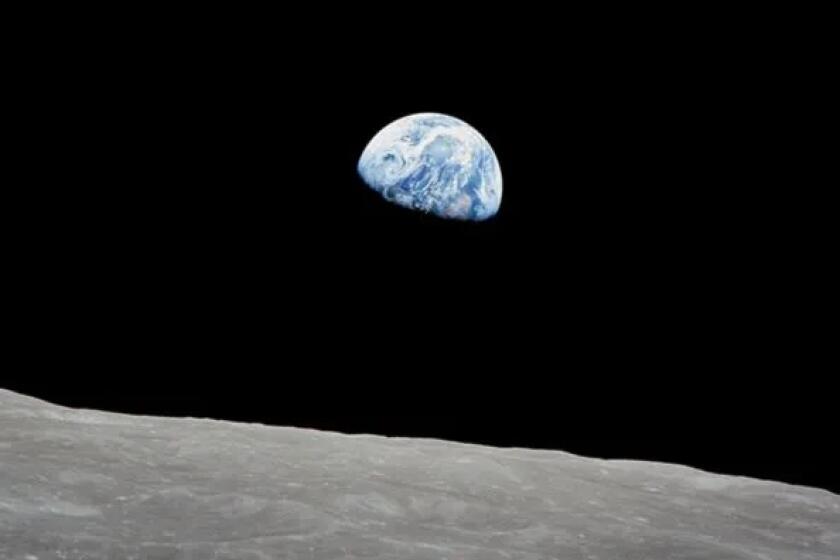Digging Up the Past : The area is a treasure trove of fossil remains of ancient creatures, but you have to know what you’re doing to locate them.
Eleven-thousand years after extinction, Ice Age pygmy mammoths were making news in 1994. Last summer--in a discovery that one expert called “spectacular”--scientists unearthed the most complete skeleton of the species ever found anywhere in the world.
While paleontologists rejoiced, you were probably less interested in the pygmy mammoth than the fact that it was discovered on Santa Rosa Island, a mere 30 miles off the Ventura County coast. Is it possible, you wondered? Could the county be a prehistoric fossil graveyard?
“It’s true,” said Ray Meisenheimer, a longtime Ventura fossil hunter. “The county is sitting on a fossil bed. Practically anyplace you go, you can find a fossil.”
You may be inspired right now to start digging for dinosaur bones in your back yard--wouldn’t a Allosaurus rib look great on the coffee table?--but postpone excavation until you read this. It takes more than a field trip to “Jurassic Park” to become a fossil hunter.
“You can’t learn fossil hunting at the movies,” Meisenheimer, 78, said with a chuckle.
The education of a fossil hunter requires a study of geology, zoology and botany. Which is why no self-respecting fossil hunter would ever look for dinosaur remains in Ventura County: Dinosaurs were extinct for perhaps 50 million years before the county emerged from the sea.
“Fossil hunting is a great hobby,” said Bruno Benson, Meisenheimer’s 80-year-old buddy and curator of the tiny Ventura Earth Science Museum. “But you really have to know what you’re doing.”
To a fossil hunter, fossils are records of life on Earth, helping explain why some species vanished and others survived. Seldom are complete remains found. Instead, fossil hunters have to use bits of mineralized bone or shell or impressions embedded in rock to decipher the past. While some fossils literally can be picked off the ground, the rare ones, those that will be displayed under glass, are hidden, but sometimes only centimeters beneath the surface. A fossil hunter has to be a detective, following clues and hunches, but relying on knowledge.
Fossil hunting also rewards hunters by giving them a deeper perspective on their own place in the universe.
“Knowing the past gives me a feeling of continuity,” said Ed Mercurio, a paleontologist with expertise in fossils found in the county. “I can be in a place and know exactly what it was like millions of years ago and what the animals faced for survival. It’s like seeing things in 3-D.”
Paleontologists are the major leaguers among fossil hunters. Working under government permits allowing them to hunt on public land, they bag the dramatic prehistoric trophies, the Cro-Magnon skull, the T-Rex jawbone, even the Santa Rosa Island pygmy mammoth. Although amateur fossil hunters have made major discoveries, county hunters go after smaller game: fossils usually no bigger than pocket change.
This disappoints many beginners, but it shouldn’t. Fossil hunters will tell you that size has nothing to do with the thrill of discovery. Some hunters, Bruno Benson included, even prefer micro-fossils. The rush comes from finding a rare fossil, but even an ordinary fossil, no matter how small, can excite the hunter.
“When you find something that’s 5 or 10 million years old--something that was once alive --and when you’re the first person who’s ever seen it, it’s just the greatest feeling,” Meisenheimer said.
A fossil doesn’t even have to be rare to be prized. “If it’s your first fossil, it’s very valuable to you,” said Dave Champion, an Oxnard fossil hunter.
You could read a few books, buy a good map and become a fossil hunter on your own, but the best way to forge ahead is by getting in touch with any of the three clubs in the county.
Your first lesson will include some basic facts: The Earth formed 4.5 billion years ago; life began a billion years or so later. As many as 50 million species of plants and animals may have existed; scientists have named and described only about 1.7 million, but you are not required to memorize all of them.
The oldest fossils found in the county are starfish and sand dollars in the Pine Mountain area north of Ojai. They date to the Eocene Period, perhaps 55 million years ago, when seawater covered most of Southern California. About 25 million years ago, underwater volcanoes and tectonic forces began forming mountain ranges, lifting the county from the sea. Ice ages occurred every few hundred-thousand years, raising ocean levels and inundating the county. Glaciers, however, never paid a visit.
The county’s aquatic history left a large assortment of deep-water marine fossils. Some of the best specimens discovered in the county were actually found on what were once ancient sand beaches in a Simi Valley canyon: giant alligators, whale skeletons as long as 40 feet, and an extremely rare seven-inch tooth from an ancestor of a great white shark. Today in the same area, basketball-sized vertebrae from 15-million-year-old baleen whales await the knowing fossil hunter.
“Once you know what to look for, they’re pretty easy to find, but if you don’t, you’d probably pass up a lot of them,” said Mercurio, who found the shark’s tooth in 1961 and loaned it to the Los Angeles County Natural History Museum.
Mercurio considers area a marvel of paleontological diversity. “What’s fascinating about Ventura County,” said Mercurio, who has a master’s degree from UCLA and teaches at Hartnell Community College in Salinas, “is that you can walk through time, from Paleocene up to Pleistocene, from underwater formations to tropical rain forest, in just a single canyon.”
In the 1930s, Las Posas Hills in Camarillo yielded one of the country’s largest mammal fields. According to “Rock & Gem” magazine, “Among the numerous finds were early saber-toothed cats, an early rhinoceros, primitive carnivores, a primitive hedgehog and an early lemur monkey.”
Evidence of prehistoric horses and camels is also found in the county. “The horse originated in (what is now) the United States, became extinct and was brought back by the Spanish,” said Meisenheimer, who has found horse teeth in Camarillo.
An example of a tiny fossil on everybody’s wish list is the Ventura County starfish. Collectors worldwide prize the well-preserved remains of the four-inch creature, which has five slender arms. Pursued by many, the starfish is elusive. “It can be found,” Meisenheimer said, “but not by me. I wish I had one.”
Santa Barbara and Los Angeles counties are also as rich as Ventura County in fossils. The region’s most famous fossil graveyard is the LaBrea Tar Pits in Los Angeles. Old-timers also recall one in Carpinteria. But in the 1920s, the pit became a town dump and the tar was used to build roads; today, it’s a parking lot, asphalt covering its secrets.
Along canyons, washes and road cuts, rains can wash fossils from their hiding places, exposing them for easy collection. Although fossil hunters are out in force after a rain, they don’t do much surface hunting--the best specimens get nabbed in a hurry. The time-honored practice of digging with a small trowel or scratching the dirt with a three-pronged hand rake pays off for experienced collectors, who usually limit their search to an area of five or six yards.
“You have to do a lot of crunching around on your hands and knees,” Mercurio said.
(BEGIN TEXT OF INFOBOX / INFOGRAPHIC)
‘Fossil Petting Zoo’ the Place to Learn
The best way to get involved in fossil hunting?
“Call Bruno,” said Dave Champion, a fossil hunter from Oxnard.
Bruno Benson, 80, is the curator of Ventura’s Earth Science Museum, nicknamed a “fossil petting zoo.” Benson and the museum’s owner, the Ventura Gem & Mineral Society, are eager to initiate the public into the joys of fossil hunting.
“We’ll open the museum for one person,” Benson said.
“Anybody who wants to start up, we’ll be glad to help,” said Ray Meisenheimer, a museum volunteer.
The museum, housed in an old home off Ventura Avenue, is crammed with fossils, most from the county. Glass cases displaying small marine fossils are overpowered by vertebrate remains, like the hefty thigh bone of a 10-foot-long sea creature called Desmostylia, discovered near Oak View.
The society has a traveling fossil collection for schools and also sponsors field trips for students. “Kids are good for 45 minutes in the field,” Meisenheimer said. “Then, you know kids. The minute they can’t find a fossil, they start wandering off.”
The museum is free. Schools can take tours by appointment.
The Ventura club supplied the fossils for the Gull Wings Children’s Museum in Oxnard. Although Gull Wings offers many other innovative hands-on activities for children, the fossil pit is popular, enabling kids to find fossils buried in sand.
“They can’t wait to find the shark tooth,” said Jeanne Taylor, assistant director of the museum. “And the older kids get, the more they like to find stuff.”
LOCAL CONTACTS
All three gem and mineral clubs in the county--Ventura, Oxnard and Conejo--have fossil collectors among their members. The clubs often take combined field trips and sponsor children’s programs.
* Conejo Gem & Mineral Club--498-4220
* Oxnard Gem & Mineral Club--483-6871
* Ventura Gem & Mineral Society (Bruno Benson)--646-5976
* Gull Wings Children’s Museum--483-3005. 418 W. 4th St., Oxnard. Admission: $3 adults, $2 children.



